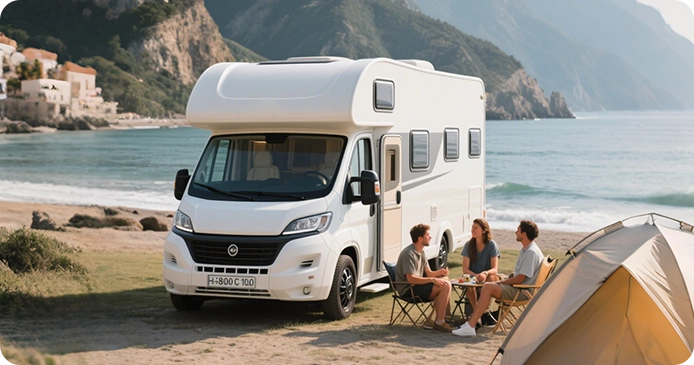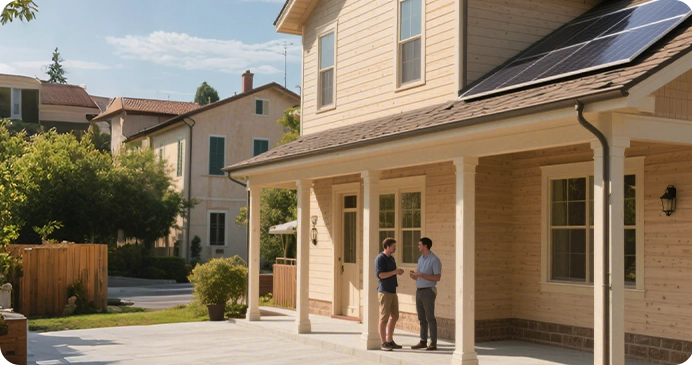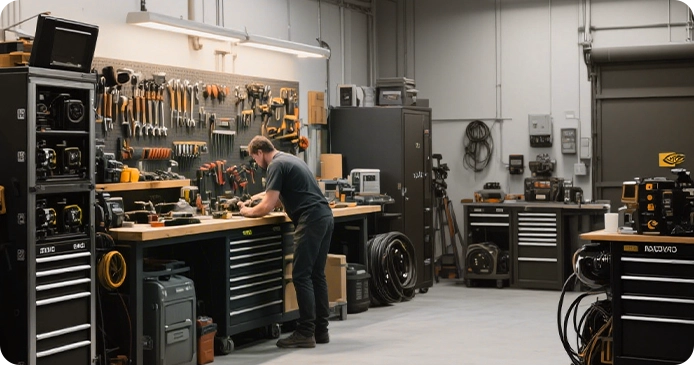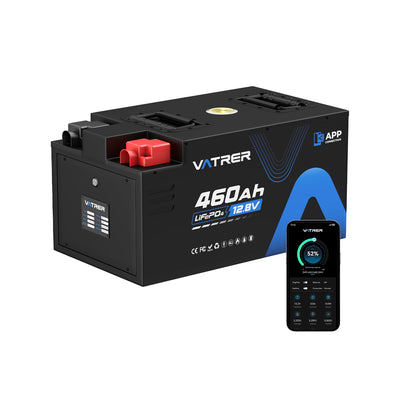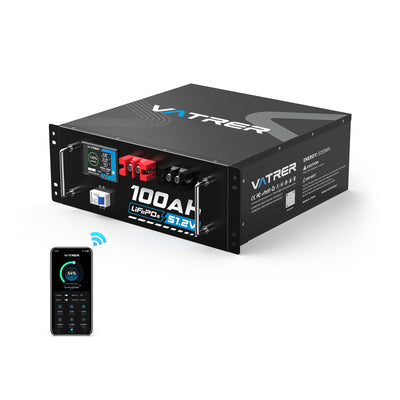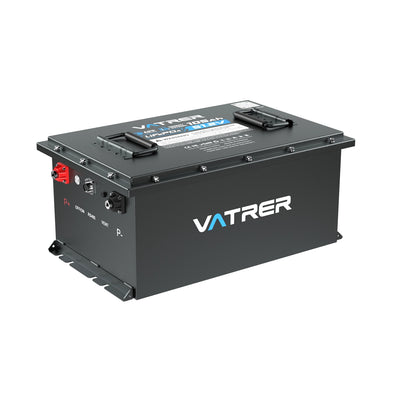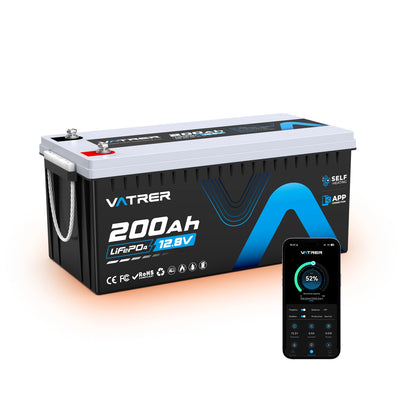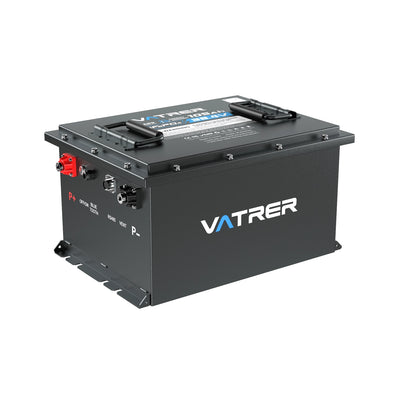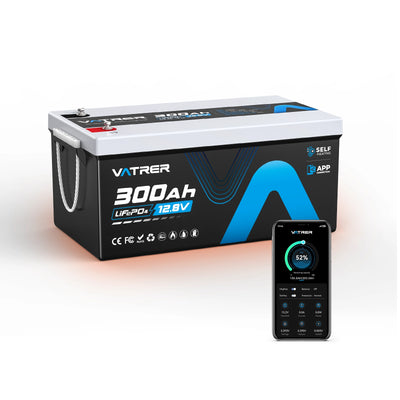Startseite
>
Erhalten Sie die neuesten Nachrichten aus der LiFePo4-Batteriebranche
>
Sind Golfwagenbatterien Deep-Cycle-Batterien?

Sind Golfwagenbatterien Deep-Cycle-Batterien?
von/ durch
Emma Larson
am Aug 25 2025
Reading time: 13 minutes
Ein Golfwagen ist eine praktische Möglichkeit, sich auf dem Golfplatz oder in der Nachbarschaft fortzubewegen, doch seine Leistung hängt oft von einer Schlüsselkomponente ab: der Batterie. Sind Golfwagenbatterien für den Tiefzyklusbetrieb geeignet? Die Antwort lautet: Ja. Zu verstehen, warum, ist entscheidend für elektrische Golfwagen, insbesondere im Hinblick auf Leistung, Kosten und Lebensdauer.
Dieser Artikel befasst sich mit der Bedeutung von Deep-Cycle-Golfwagenbatterien, Batterietypen, Wartungstipps und wie Sie die richtige Batterie für Ihre Bedürfnisse auswählen, damit Sie eine fundierte Entscheidung treffen und Ihren Golfwagen reibungslos in Betrieb halten können.
Was sind Deep-Cycle-Batterien?
Deep-Cycle-Batterien sind speziell dafür ausgelegt, über lange Zeiträume eine konstante Leistung zu liefern, im Gegensatz zu Autobatterien, die nur kurze Energieimpulse zum Starten des Motors abgeben.
Diese Batterien können wiederholt entladen und aufgeladen werden, typischerweise bis zu 80-100 % ihrer Kapazität, ohne dass es zu nennenswerten Schäden kommt. Es wird jedoch empfohlen, die Batterien nur bis zu 45-50 % aufzuladen, um die Belastung der Batteriechemie zu reduzieren und ihre Lebensdauer zu verlängern.
Eine 12-V- Golfwagenbatterie mit Tiefentladungsschutz kann Ihren Wagen beispielsweise über mehrere Golfrunden oder stundenlange Erledigungen mit Strom versorgen, während eine Autobatterie unter solch anhaltender Belastung versagen würde.
Anders als Starterbatterien für benzinbetriebene Fahrzeuge sind Deep-Cycle-Batterien für wiederholte Lade- und Entladezyklen ausgelegt. Sie kommen in Anwendungen wie Golfwagen, Wohnmobilen, Gabelstaplern und Systemen für erneuerbare Energien zum Einsatz, wo lange Laufzeiten entscheidend sind.
Golfwagenbatterien sind aufgrund der unterschiedlichen Spannungssysteme (z. B. 36 V oder 48 V für Golfwagen gegenüber 12 V für Autos) und der unterschiedlichen Lastanforderungen nicht mit Autobatterien austauschbar. So wird eine optimale Leistung für die spezifischen Bedürfnisse Ihres Golfwagens gewährleistet.
Lesen Sie weiter, um mehr zu erfahren: Was sind Deep-Cycle-Batterien?

Warum werden elektrische Golfcarts mit Deep-Cycle-Batterien betrieben?
Elektrische Golfwagen sind auf Deep-Cycle-Batterien angewiesen, um eine konstante Leistung zu gewährleisten, insbesondere unter anspruchsvollen Bedingungen wie hügeligem Gelände, hoher Passagierlast oder längeren Fahrten.
Ob Sie nun 18 Löcher spielen oder sich in einem Resort bewegen – diese Batterien sorgen für einen reibungslosen Betrieb Ihres Golfcarts ohne plötzliche Stromausfälle. Im Gegensatz dazu benötigen benzinbetriebene Golfcarts Starterbatterien, um den Motor zu starten, ähnlich wie Autos.
Die Verwendung einer Deep-Cycle-Batterie in einem Benzin-Cart oder einer Starterbatterie in einem Elektro-Cart kann die Leistung verringern und die Lebensdauer der Batterie verkürzen. Daher ist es entscheidend, den richtigen Batterietyp zu wählen.
Deep-Cycle-Batterien sind in verschiedenen Spannungen erhältlich, z. B. 6-V-, 8-V- und 12-V-Batterien für Golfcarts. Diese werden in Reihe geschaltet, um zum System Ihres Golfcarts zu passen. Sechs 6-V-Batterien für ein 36-V-System oder vier 12-V-Batterien für ein 48-V-System. Die Wahl der richtigen Spannung und des passenden Batterietyps gewährleistet Kompatibilität und maximale Effizienz und sorgt so für die Zuverlässigkeit Ihres Golfcarts – auf dem Golfplatz und darüber hinaus.
Vatrer bietet Flottenmanagern und Golfbegeisterten ein Komplettset mit Lithium-Ionen-Batterien für Golfcarts . Unsere Batterien zeichnen sich durch hohe Leistung und große Reichweite aus, sodass Sie mit einer einzigen Ladung mehrere Runden mit 18 bis 36 Löchern spielen können. Dank ihres geringen Gewichts wird das Gesamtgewicht Ihres Golfcarts reduziert, was den Energieverbrauch senkt und Reichweite sowie Steigfähigkeit verbessert.
Wenn Sie eine Hochleistungsbatterie suchen, entdecken Sie jetzt die Vatter Golfwagenbatterien mit 36 V , 48 V oder 72 V!
Welche Arten von Deep-Cycle-Golfwagenbatterien gibt es?
Besitzern von Golfcarts stehen verschiedene Optionen für Deep-Cycle-Batterien zur Verfügung, jede mit ihren eigenen Merkmalen. Wenn Sie diese Typen kennen, können Sie die beste Batterie für Ihre Bedürfnisse, Ihr Budget und Ihre Wartungsanforderungen auswählen.
Geflutete Blei-Säure-Batterien
- Preisgünstigste Option, weit verbreitet bei Golfwagen.
- Regelmäßige Wartung ist erforderlich, einschließlich des Nachfüllens mit destilliertem Wasser und der Reinigung der Batteriepole, um Korrosion zu verhindern.
- Bieten eine Lebensdauer von 300-500 Zyklen, die kürzeste unter den Deep-Cycle-Batterien.
AGM-Batterien (Absorbent Glass Mat)
- Versiegelte, wartungsfreie Konstruktion mit in Glasfasermatten eingeschlossenem Elektrolyten, wodurch sie auslaufsicher und vibrationsbeständig sind, ideal für unwegsames Gelände.
- Bieten Sie eine Lebensdauer von 500-1.000 Zyklen und achten Sie dabei auf ein ausgewogenes Verhältnis zwischen Haltbarkeit und Kosten.
- Teurer als geflutete Blei-Säure-Batterien, aber wartungsärmer.
Lithium-Ionen-Batterien (LiFePO4)
- Sie sind leicht und haben eine Lebensdauer von 2.000 bis 4.000 Zyklen, wodurch sie sich ideal für häufige Nutzer eignen.
- Sie benötigen minimalen Wartungsaufwand und laden schneller als Bleiakkumulatoren. Vatter Lithium-Ionen-Akkus verfügen über fortschrittliche Batteriemanagementsysteme (BMS) zum Schutz vor Überladung, zur Gewährleistung der thermischen Stabilität und zur App-basierten Überwachung der Leistung in Echtzeit.
- Höhere Anschaffungskosten, bieten aber aufgrund von Langlebigkeit und Effizienz langfristige Einsparungen.
Um Ihnen die Entscheidung zu erleichtern, finden Sie hier einen Vergleich wichtiger Kennzahlen, der Ihnen bei der Auswahl einer Batterie hilft, die Ihren Prioritäten entspricht:
| Akku-Typ | Kosten | Lebensdauer (Zyklen) | Wartung | Gewicht | Hauptmerkmal |
|---|---|---|---|---|---|
| Geflutete Blei-Säure | Niedrig | 300-500 | Hoch (Bewässerung, Reinigung) | Schwer | Budgetfreundlich |
| Hauptversammlung | Medium | 500-1.000 | Keiner | Mäßig | Auslaufsicher, vibrationsbeständig |
| Lithium-Ionen (LiFePO4) | Hoch | 2.000–4.000 | Minimal | Licht | Schnellladung, BMS-fähig |
Vor- und Nachteile von Deep-Cycle-Golfwagenbatterien
Obwohl Deep-Cycle-Golfwagenbatterien speziell für elektrische Golffahrzeuge entwickelt wurden, hat jeder Typ seine Vor- und Nachteile. Die folgende detaillierte Beschreibung soll Ihnen helfen, den passenden Batterietyp zu finden und die richtige Wahl zu treffen.
Vorteile von Golfwagenbatterien mit Tiefentladungsfunktion
- Langlebigkeit : Entwickelt für wiederholte Lade- und Entladezyklen, perfekt für den häufigen Einsatz im Golfwagen.
- Konstante Leistung : Liefert über lange Zeiträume hinweg konstante Energie und gewährleistet so einen zuverlässigen Betrieb auch auf längeren Fahrten.
- Längere Lebensdauer : Lithium-Ionen-Batterien, wie beispielsweise die LiFePO4-Modelle von Vatter Battery , können aufgrund ihrer thermischen Stabilität und hohen Zyklenlebensdauer bis zu 8-10 Jahre halten, im Vergleich zu 2-3 Jahren bei Blei-Säure-Batterien.
- Umweltfreundliche Optionen : Sowohl Lithium-Ionen- als auch Blei-Säure-Batterien sind recycelbar, Lithium-Ionen-Batterien haben jedoch aufgrund ihrer ungiftigen Chemie und höheren Energieeffizienz eine geringere Umweltbelastung.
Nachteile einer Golfwagenbatterie mit Tiefenzyklus
- Kosten : Lithium-Ionen- und AGM-Batterien haben höhere Anschaffungskosten als geflutete Blei-Säure-Batterien.
- Wartung : Geflutete Blei-Säure-Batterien benötigen regelmäßige Pflege, wie z. B. das Nachfüllen von Wasser und die Reinigung der Anschlüsse mit Natron, um Korrosion zu entfernen.
- Empfindlichkeit : Überladung oder Entladung unter 50 % kann die Batterielebensdauer verkürzen, Lithium-Ionen-Batterien mit BMS, wie die von Vatter, verfügen jedoch über einen automatischen Schutz, um diese Risiken zu minimieren.
Lithium-Ionen-Batterien, insbesondere LiFePO4-Modelle, erfreuen sich aufgrund ihres geringen Gewichts, ihrer thermischen Stabilität und ihrer fortschrittlichen Funktionen zunehmender Beliebtheit und sind daher eine Top-Wahl für Golfwagenbesitzer, die Wert auf Zuverlässigkeit und Komfort legen.
Wie man Deep-Cycle-Golfwagenbatterien pflegt
Die richtige Wartung gewährleistet optimale Leistung und eine längere Lebensdauer Ihrer Golfwagenbatterien. So pflegen Sie die einzelnen Batterietypen:
Geflutete Blei-Säure-Batterien
- Kontrollieren Sie monatlich den Wasserstand und füllen Sie ihn gegebenenfalls mit destilliertem Wasser auf, um eine Ansammlung von Metallionen (Eisen) zu verhindern, die die Leistung beeinträchtigen kann.
- Reinigen Sie die Batteriepole mit einer Lösung aus Backpulver und Wasser, um Korrosion zu entfernen und einen guten elektrischen Kontakt zu gewährleisten.
- Führen Sie alle paar Wochen einen Ausgleichslauf mit dem Ausgleichsmodus des Ladegeräts durch, um Säure und Wasser zu vermischen und so eine Schichtung zu verhindern, die die Batterie beschädigen kann.
Achtung : Eine fehlerhafte Ausgleichsladung kann zu Überladung führen. Beachten Sie daher die Anweisungen des Ladegeräts genau.
AGM-Batterien
- Wartungsfrei, aber an einem kühlen, trockenen Ort lagern, um Hitzeschäden zu vermeiden.
- Um die Zuverlässigkeit zu gewährleisten, sollten Sie regelmäßig auf physische Beschädigungen oder lose Verbindungen prüfen.
Lithium-Ionen-Batterien
- Dank integrierter Batteriemanagementsysteme (BMS), die Überladung, Überhitzung und Tiefentladung verhindern, ist der Wartungsaufwand minimal, was die Pflege für den Benutzer vereinfacht.
- Um die Leistungsfähigkeit zu erhalten, sollten die Anschlüsse sauber gehalten und in einer kühlen, trockenen Umgebung gelagert werden.
Die Lithium-Ionen-Batterien von Vatter Battery bieten ein Batteriemanagementsystem (BMS) und eine App-basierte Überwachung, mit der Sie Ladezustand und Zustand über Ihr Smartphone verfolgen können, was die Wartung zum Kinderspiel macht.
Bei allen Golfwagenbatterien sollte der Ladezustand nicht unter 50 % sinken, um langfristige Schäden zu vermeiden. Neue Batterien benötigen 20 bis 50 vollständige Ladezyklen, um ihre chemische Zusammensetzung zu entwickeln und ihre maximale Kapazität zu erreichen. So wird eine optimale Leistung über die gesamte Lebensdauer gewährleistet. Verwenden Sie für sicheres und effizientes Laden stets ein Ladegerät, das mit Ihrem Batterietyp kompatibel ist.
So laden Sie eine Deep-Cycle-Golfwagenbatterie
Korrekte Ladepraktiken sind entscheidend für eine längere Akkulaufzeit und höhere Zuverlässigkeit. Beachten Sie folgende Tipps:
- Ladezustand überwachen : Überprüfen Sie die Spannung mit einem Multimeter. Eine vollständig geladene 6-V-Golfwagenbatterie (Tiefzyklusbatterie) hat eine Spannung von ca. 6,37 Volt, eine 12-V-Batterie hingegen ca. 12,73 Volt. Laden Sie die Batterie auf, bevor der Ladezustand unter 50 % fällt (z. B. 12,3 Volt bei einer 12-V-Batterie), um eine Überlastung zu vermeiden.
- Verwenden Sie das richtige Ladegerät : Achten Sie darauf, dass Ihr Ladegerät zum Akkutyp passt. Lithium-Ionen-Akkus, wie beispielsweise die LiFePO4-Akkus von Vatrer, benötigen spezielle Ladegeräte, um optimale Leistung zu gewährleisten und Schäden zu vermeiden. Vatrer bietet Golfwagen-Akkusets inklusive Ladegerät an, damit Sie sich keine Gedanken mehr um das Laden machen müssen und Ihre Investitionskosten sinken.
- Tiefentladung vermeiden : Lithium-Ionen-Batterien sollten bei 20-40 % ihrer Kapazität und Blei-Säure-Batterien bei 45 % aufgeladen werden, um ihre Funktionstüchtigkeit zu erhalten.
- Nutzungsplan : Verwenden Sie ein Bordladegerät oder führen Sie ein tragbares Ladegerät mit, um eine ausreichende Stromversorgung für Ihre Reise sicherzustellen und so einen unerwarteten Stromausfall und eine Überlastung der Batterie zu vermeiden.
Diese Maßnahmen sorgen dafür, dass Ihr Akku voll aufgeladen und einsatzbereit bleibt, egal ob Sie eine hügelige Strecke bewältigen oder einen langen Tag mit Erledigungen vor sich haben.
Die beste Deep-Cycle-Batterie für Ihren Golfwagen auswählen
Bei der Auswahl der richtigen Batterie müssen Sie Ihre Bedürfnisse, den Wagentyp und Ihr Budget in Einklang bringen.
- Passender Fahrzeugtyp : Elektrische Golfcarts benötigen Deep-Cycle-Batterien, während benzinbetriebene Golfcarts Starterbatterien verwenden. Prüfen Sie die Spannung Ihres Carts (36 V oder 48 V) und wählen Sie kompatible Batterien, z. B. 6-V-, 8-V- oder 12-V-Deep-Cycle-Batterien. Da Elektrofahrzeuge hohe Anforderungen an die Batterieleistung stellen, wird von einer Hochspannung durch Reihen-Parallel-Schaltung abgeraten. Dieses Problem lässt sich durch den Kauf einer Vatter 36-V- oder 48-V-Lithiumbatterie lösen.
- Berücksichtigen Sie Ihr Nutzungsverhalten : Häufige Nutzer profitieren von Lithium-Ionen-Akkus aufgrund ihrer längeren Lebensdauer und des geringen Wartungsaufwands. Für gelegentlichen Gebrauch können herkömmliche Bleiakkumulatoren ausreichend sein, sofern Sie den Wartungsaufwand nicht scheuen.
- Kostenvergleich : Geflutete Blei-Säure-Batterien sind zwar kostengünstig, erfordern aber mehr Wartung und müssen häufiger ausgetauscht werden. Lithium-Ionen-Batterien, wie beispielsweise die LiFePO4-Modelle von Vatter Battery, sind in der Anschaffung zwar teurer, sparen aber langfristig Geld durch ihre Lebensdauer von 2.000 bis 4.000 Ladezyklen und den geringen Wartungsaufwand, wodurch die Gesamtbetriebskosten sinken.
- Kompatibilität prüfen : Stellen Sie sicher, dass die Abmessungen und die Kapazität der Batterie mit den Spezifikationen Ihres Golfcarts übereinstimmen. Für Lithium-Ionen-Akkus sind möglicherweise Nachrüstsätze erforderlich, z. B. für die Batteriehalterung oder Anpassungen der Verkabelung. Wenden Sie sich daher an den Hersteller Ihres Golfcarts oder an einen Fachmann von Vatter.
Die Vatrer-Golfwagenbatterie mit einer Lebensdauer von 8-10 Jahren, Schnellladefunktion und BMS für mehr Sicherheit liefert eine konstante Leistung sowohl für Gelegenheitsnutzer als auch für Vielnutzer und ist somit ideal für moderne Golfwagenanwendungen geeignet.
Abschluss
Die Batterien von Elektro-Golfcarts sind deren Herzstück und liefern die konstante Leistung, die für zuverlässige Performance notwendig ist. Ob Sie sich für eine herkömmliche Blei-Säure-Batterie, eine AGM-Batterie oder eine Lithium-Ionen-Batterie entscheiden – wenn Sie die Unterschiede und Wartungsanforderungen kennen, holen Sie das Beste aus Ihrem Golfcart heraus.
Bereit für ein Upgrade der Leistung Ihres Golfcarts? Entdecken Sie die Deep-Cycle-Golfcart-Batteriesets von Vatter und finden Sie die besten Deep-Cycle-Batterieoptionen – leicht, effizient und langlebig –, damit Sie auf und neben dem Golfplatz stets mit Strom versorgt sind.
Sie möchten mehr über Deep-Cycle-Golfwagenbatterien erfahren? Lesen Sie weiter, um Details zu erfahren:
Was kostet der Austausch einer Golfwagenbatterie?
Wozu werden Lithium-Batterien mit Tiefentladefunktion verwendet?
Wie lange halten Deep-Cycle-Batterien?
Häufig gestellte Fragen/Häufig gestellte Fragen
Worin besteht der Unterschied zwischen einer Golfwagenbatterie und einer Deep-Cycle-Batterie?
Eine Golfwagenbatterie ist typischerweise eine Deep-Cycle-Batterie für Elektro-Golfwagen, die für eine konstante Stromversorgung über längere Zeiträume, beispielsweise während einer Golfrunde, ausgelegt ist. Allerdings sind nicht alle Golfwagenbatterien Deep-Cycle-Batterien. Benzinbetriebene Golfwagen verwenden Starterbatterien für kurze Energiestöße zum Starten des Motors, ähnlich wie Autobatterien. Deep-Cycle-Batterien , darunter 6-V-, 8-V- oder 12-V-Golfwagenbatterien, sind eine spezielle Kategorie, die für wiederholte Lade- und Entladezyklen entwickelt wurde und in Elektro-Golfwagen, Wohnmobilen und anderen Anwendungen mit Dauerstrombedarf eingesetzt wird. Prüfen Sie immer den Typ Ihres Golfwagens (elektrisch oder benzinbetrieben), um die richtige Batterie auszuwählen, da die Verwendung einer Starterbatterie in einem Elektro-Golfwagen zu Leistungseinbußen und einer kürzeren Lebensdauer führen kann.
Sind Autobatterien Deep-Cycle-Batterien?
Autobatterien sind keine Deep-Cycle-Batterien. Es handelt sich um Starterbatterien, die kurze, aber kraftvolle Energiestöße zum Starten des Fahrzeugmotors liefern. Im Gegensatz zu Deep-Cycle-Batterien für Golfwagen, die über längere Zeiträume eine konstante Leistung bereitstellen und wiederholte Lade- und Entladezyklen (bis zu 80–100 % Entladung) verkraften, sind Autobatterien für geringe Entladungen (typischerweise 10–20 %) und schnelles Aufladen über die Lichtmaschine des Fahrzeugs optimiert.
Die Verwendung einer Autobatterie in einem Elektrogolfwagen würde zu schnellem Verschleiß und unzureichender Leistung für den Dauerbetrieb führen. Wenn Sie eine Batterie für einen Elektrogolfwagen benötigen, wählen Sie eine Deep-Cycle-Batterie, wie beispielsweisedie Vatter Lithium-Golfwagenbatterie . Diese bietet eine längere Lebensdauer und eine konstante Leistungsabgabe für optimale Performance.
Woran erkenne ich, ob die Batterie meines Golfcarts schwach ist, und was sollte ich tun?
Anzeichen für eine schwächelnde Golfwagenbatterie sind unter anderem eine verkürzte Laufzeit, z. B. hält die Batterie nicht für eine ganze Golfrunde durch, langsame Beschleunigung, schwächer werdende Zubehörteile (Beleuchtung) oder eine Multimeteranzeige, die deutlich unter der erwarteten Spannung liegt (unter 6 V bei einer 6-V-Batterie oder unter 12 V bei einer 12-V-Batterie im voll geladenen Zustand).
Bei gefluteten Blei-Säure-Batterien sollten Sie den Wasserstand prüfen und gegebenenfalls Sulfatierung (weiße Ablagerungen an den Polen) feststellen. Falls Sie diese Probleme bemerken, führen Sie zunächst Wartungsarbeiten durch: Reinigen Sie die Pole mit einer Natronlösung oder stellen Sie sicher, dass die Batterie mit einem kompatiblen Ladegerät ordnungsgemäß geladen wird.
Bei Lithium-Ionen-Akkus prüfen Sie bitte die App (sofern verfügbar, z. B. bei Modellen von Vatter Battery) auf Diagnosewarnungen. Sollten die Probleme weiterhin bestehen, wenden Sie sich bitte an einen Fachmann oder tauschen Sie den Akku aus. Achten Sie dabei darauf, dass der neue Akku die Spannung (36 V oder 48 V) und den Typ Ihres Golfwagens hat.
Kann ich in meinem Golfwagen verschiedene Batterietypen mischen?
Die Verwendung unterschiedlicher Batterietypen, wie z. B. Lithium-Ionen- und Blei-Säure-Batterien, in einem Golfwagen wird nicht empfohlen. Jeder Typ hat spezifische Spannungs-, Lade- und Entladeeigenschaften. Die Verwendung verschiedener Typen kann zu ungleichmäßiger Leistungsabgabe, Leistungseinbußen und Schäden an den Batterien oder der Bordelektronik des Golfwagens führen.
Lithium-Ionen-Akkus laden beispielsweise schneller und haben eine andere Spannungskurve als Bleiakkus. Dies kann in einer Reihenschaltung (z. B. einem 36-V-System mit sechs 6-V-Akkus) zu Spannungsungleichgewichten führen. Wenn Sie auf Lithium-Ionen-Akkus umsteigen, wie beispielsweise die LiFePO4-Modelle von Vatter Battery, sollten Sie alle Akkus gleichzeitig austauschen, um die Kompatibilität sicherzustellen. Konsultieren Sie die Bedienungsanleitung Ihres Golfcarts oder einen Fachmann, um die korrekte Konfiguration zu überprüfen und kostspielige Probleme zu vermeiden.
Wie lange dauert das Aufladen einer Deep-Cycle-Golfwagenbatterie?
Die Ladezeit einer Golfwagenbatterie hängt vom Batterietyp, der Kapazität und der Ladeleistung des Ladegeräts ab. Nassbatterien und AGM-Batterien benötigen typischerweise 6–12 Stunden, um mit einem Standard-Ladegerät (10–15 Ampere, 48-V-System, 100 Ah Kapazität) von 50 % Kapazität vollständig geladen zu werden.
Lithium-Ionen-Akkus, wie beispielsweise die LiFePO4-Modelle von Vatter, laden aufgrund ihrer höheren Ladeeffizienz schneller, oft in 3-6 Stunden, insbesondere mit einem kompatiblen Hochleistungsladegerät (20-30 Ampere).
Um die Ladezeit abzuschätzen, teilen Sie die Amperestunden-Kapazität (Ah) der Batterie durch die Ampere-Ausgangsleistung des Ladegeräts und rechnen Sie 10–20 % für Ladeverluste hinzu. Verwenden Sie stets ein Ladegerät, das zum Batterietyp passt, und vermeiden Sie Überladung, indem Sie den Ladevorgang überwachen oder ein intelligentes Ladegerät verwenden.
Kann ich die Batterie meines Golfwagens auch bei extremen Wetterbedingungen verwenden?
Deep-Cycle-Golfwagenbatterien können unter verschiedenen Wetterbedingungen betrieben werden, jedoch beeinträchtigen extreme Temperaturen Leistung und Lebensdauer.
Blei-Säure-Batterien (geflutet oder AGM) arbeiten am besten bei Temperaturen zwischen 10 und 27 °C (50-80 °F). Extreme Kälte (unter 0 °C/32 °F) verringert die Kapazität, während Hitze (über 38 °C/100 °F) den Abbau beschleunigt.
Lithium-Ionen-Batterien, wie beispielsweise die LiFePO4-Modelle von Vatter Battery, decken dank ihrer thermischen Stabilität und ihres BMS, das die Leistung unter rauen Bedingungen reguliert, einen breiteren Temperaturbereich ab (-4°F bis 140°F/-20°C bis 60°C).
Um Batterien zu schützen, sollten Bleiakkumulatoren nicht bei Minustemperaturen geladen werden, um eine Beschädigung des Elektrolyten zu verhindern. Schützen Sie alle Batterien während des Gebrauchs vor direkter Sonneneinstrahlung und extremer Hitze. Für ganzjährige Zuverlässigkeit lagern Sie Batterien außerhalb der Saison in Innenräumen und erwägen Sie Lithium-Ionen-Akkus für eine höhere Widerstandsfähigkeit in extremen Klimazonen.
Teilen





























